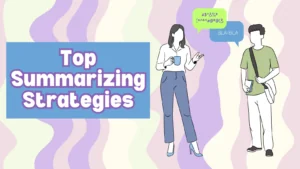Whether you are summarizing an article, a book, or a presentation, the ability to effectively summarize can help you better understand the material and communicate its key points to others. In this guide, we will explore the process of writing a summary, including tips and strategies for summarizing effectively.

✅ AI Essay Writer ✅ AI Detector ✅ Plagchecker ✅ Paraphraser
✅ Summarizer ✅ Citation Generator
A Step-by-Step Guide on Starting Your Summary
Let’s go straight ahead and look into the tips and tricks that will help you properly start your summary writing process.
| Tips | What Should You Do? |
|---|---|
| 📝 Introductory Sentence | Begin your summary with an introductory sentence that includes the title of the text, the author’s name, and the main point or thesis of the text as you understand it. For example, “In [Title], [Author] argues that [Main Point].” |
| ✏️ Write in Your Own Words | Remember to write the summary in your own words. Do not copy directly from the text. |
| 🚫 Exclude Personal Opinions | A summary should only include the ideas presented in the original text. Avoid inserting your own opinions, interpretations, deductions, or comments. |
| 📝 Identify Sub-Claims | Outline the significant sub-claims the author uses to defend the main point. These sub-claims should be presented in the same order as they appear in the text. |
| 📖 Select Supporting Passages | Choose three separate passages from the essay that support or defend the main point. Quote these passages accurately, and include the paragraph number where each passage can be found. |
| ❝❞Cite Sources Properly | Cite each passage correctly by first signaling the work and the author, putting quotation marks around the passage, and including the paragraph number. |
As you have now figured out how your summary should begin, and how your writing should be organized (approximately), you can start putting everything together. In this process, don’t forget to consider the following:
| 📚 Use Source Material | Incorporating source material from the essay is also necessary, as it shows your ability to defend claims with evidence, which is often required in academic writing. |
| 🏁 Concluding Sentence | End your summary with a concluding sentence that wraps up the main point of the text. This could be a simple rephrasing of the main point or thesis. |
| ✏️ Revise and Edit | After completing your summary, revise it to make clear, coherent, and accurate. Check for any grammatical or spelling errors and make corrections as needed. |
Structuring Your Writing
You know how to start your summary now, however, you also need to properly structure your further writing as well. Thus, before summarizing, clearly identify the main idea or thesis of the text. This will help you focus on the most important information when writing your summary. With the main idea in place, you can easily determine which details are essential to include and which can be omitted.

Highlight key details
As you read through the text, highlight or underline key details and supporting points. This will make it easier to reference them when writing your summary. Highlighting major points helps you remember important information and make sure that you include it in your summary. It also allows you to easily locate specific details when you need to refer back to the text.
Example: In a research paper about the effects of social media on mental health, you might highlight statistics about the prevalence of social media use among teenagers.
Paraphrase key points
Instead of copying sentences verbatim, rewrite the key points in your own words. This will show your understanding of the material and help avoid plagiarism. Paraphrasing helps you communicate the author’s ideas simply and clearly. It allows you to put the information in your own words too, making it easier to remember and explain.
Example: If the original text states, “Social media platforms have revolutionized the way people communicate,” you could paraphrase this as, “Social media has changed how we interact with others.”
Focus on the most important information
When writing your summary, focus on including only key points from the original material. Avoid listing minor details or examples that are not essential to understanding the main idea. Focusing on the most important information keeps your summary straight to the point.
Example: In a summary of a scientific study, you might focus on the study’s methodology and key findings, rather than on specific data points or statistical analyses.
Use transition words
Use transition words and phrases to connect your ideas and create a cohesive summary. This will make your summary flow smoothly and easier to read. Transition words help signal the relationships between different parts of your summary, such as cause and effect, comparison, and contrast. They also contribute to maintaining the overall logic of your summary.
Example: You can use transition words like “however,” “in contrast,” and “moreover” to indicate shifts in the author’s argument or to introduce new information in your summary.
Check for accuracy
After writing your summary, double-check that it reflects the main idea and key points of the original text precisely. Make any necessary corrections to improve possible inconcistencies or confusing sentences. Remember, your summary should be a faithful representation of the original text.
Example: If the original text states that “climate change is a pressing issue that requires immediate action,” your summary should accurately convey this sentiment without misrepresenting the author’s intent.
Conclusion
Writing a summary is a skill that can be honed with practice and attention to detail. So, whether you are summarizing for a school assignment, a work presentation, or personal study, following the guidelines we presented above can help you write a summary that is both effective and engaging.
Now, it is possible to speed up the summarizing process with our new AI Summary Tool. Just give it a try!
FAQ
Follow us on Reddit for more insights and updates.





Comments (0)
Welcome to A*Help comments!
We’re all about debate and discussion at A*Help.
We value the diverse opinions of users, so you may find points of view that you don’t agree with. And that’s cool. However, there are certain things we’re not OK with: attempts to manipulate our data in any way, for example, or the posting of discriminative, offensive, hateful, or disparaging material.